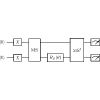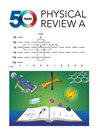Error mitigation, optimization, and extrapolation on a trapped-ion testbed
IF 2.9
2区 物理与天体物理
Q2 Physics and Astronomy
引用次数: 0
Abstract
Current noisy intermediate-scale quantum (NISQ) trapped-ion devices are subject to errors which can significantly impact the accuracy of calculations if left unchecked. A form of error mitigation called zero noise extrapolation (ZNE) can decrease an algorithm's sensitivity to these errors without increasing the number of required qubits. Here we explore different methods for integrating this error mitigation technique into the Variational Quantum Eigensolver (VQE) algorithm for calculating the ground state of the molecule at in the presence of experimental noise. Using the Quantum Scientific Computing Open User Testbed (QSCOUT) trapped-ion device, we test three methods of scaling noise for extrapolation: time stretching the two-qubit gates, scaling the sideband detuning parameter, and inserting two-qubit gate identity operations into the ansatz circuit. We find that time stretching and sideband detuning scaling fail to scale the noise on our particular hardware in a way that can be extrapolated to zero noise. Scaling our noise with global gate identity insertions and extrapolating after variational optimization, we achieve error suppression of , resulting in an energy estimate within hartree of the ground state energy. This is an improvement, but still outside the chemical accuracy threshold of 0.0016 hartree. Our results show that the efficacy of this error mitigation technique depends on choosing the correct implementation for a given device architecture.

受困离子试验平台上的误差缓解、优化和外推法
目前的高噪声中量子(NISQ)陷落离子设备会产生误差,如果不加以控制,会严重影响计算的准确性。一种名为零噪声外推法(ZNE)的误差缓解方法可以在不增加所需量子比特数量的情况下降低算法对这些误差的敏感性。在这里,我们探讨了将这种误差缓解技术集成到变分量子均衡器(VQE)算法中的不同方法,以计算存在实验噪声的 0.8Å 处 HeH+ 分子的基态。利用量子科学计算开放用户试验台(QSCOUT)的困离子装置,我们测试了三种用于外推的噪声缩放方法:时间拉伸双量子比特门、缩放边带失谐参数以及在解析电路中插入双量子比特门标识操作。我们发现,在我们的特定硬件上,时间拉伸和边带失谐缩放都无法缩放噪声,从而无法外推至零噪声。通过插入全局栅极标识来缩放噪声,并在变异优化后进行外推,我们实现了 96.8% 的误差抑制,从而将能量估计值控制在基态能量的 -0.004±0.04 哈特里范围内。这是一个进步,但仍未达到 0.0016 哈特里的化学精度阈值。我们的研究结果表明,这种误差抑制技术的有效性取决于为特定器件架构选择正确的实现方法。
本文章由计算机程序翻译,如有差异,请以英文原文为准。
求助全文
约1分钟内获得全文
求助全文
来源期刊

Physical Review A
物理-光学
CiteScore
5.40
自引率
24.10%
发文量
0
审稿时长
2.2 months
期刊介绍:
Physical Review A (PRA) publishes important developments in the rapidly evolving areas of atomic, molecular, and optical (AMO) physics, quantum information, and related fundamental concepts.
PRA covers atomic, molecular, and optical physics, foundations of quantum mechanics, and quantum information, including:
-Fundamental concepts
-Quantum information
-Atomic and molecular structure and dynamics; high-precision measurement
-Atomic and molecular collisions and interactions
-Atomic and molecular processes in external fields, including interactions with strong fields and short pulses
-Matter waves and collective properties of cold atoms and molecules
-Quantum optics, physics of lasers, nonlinear optics, and classical optics
 求助内容:
求助内容: 应助结果提醒方式:
应助结果提醒方式:


